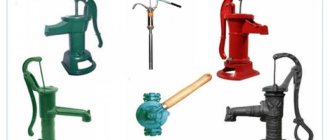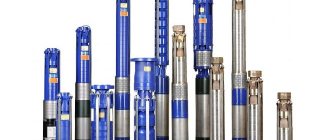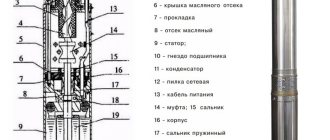Have you encountered the problem of submersible equipment getting stuck in the shaft and being unable to extract it to the surface? Agree, it’s not a bad idea to pull it out on your own, restoring uninterrupted water supply, and at the same time saving on the cost of visiting a specialist. But you don’t know how to remove the pump from the well without damaging it?
We will tell you how you can cope with this task yourself - the article discusses the most common causes of a stuck pump and methods for removing it. Video recommendations from professionals are provided and the equipment used in this case is reviewed.
The article also contains photographic materials demonstrating methods for removing a submersible pump operated at great depths. The recommendations given will help to cope with the problem if the reason why the unit is stuck, its type and the condition of the casing pipe allow this to be done.
Emergency
Getting a pumping device stuck in a well is, to put it mildly, not a pleasant situation.
It usually occurs when trying to lift the device to the surface for routine maintenance or repairs. As a result, a stalemate arises: the pumping equipment does not work and it cannot be repaired either, because there is no access to it. In some cases, you will be able to independently remove the pumping equipment from the well without damaging it, but sometimes you have to say goodbye to the pump. In the most extreme situation, the water well is completely out of order.
Getting a pump stuck in a well is an emergency
How to prevent pump lifting problem
Pulling a deep well pump out of a well with your own hands if it comes off is not at all difficult if you follow all the recommendations of specialists.
The catchphrase is: “Forewarned is forearmed.” To prevent unpleasant situations from occurring, you need to follow a number of simple rules that can save equipment, time and money.
- Work only with strong cables. You can't skimp on this item. Choose quality products and fasteners.
- The hose must be intact. Buy one of sufficient length, even if the one included in the kit does not meet the required parameters. This will reduce the risk of breakage significantly.
- Choose the right size. The unit should be one third of the diameter of the pipe. Otherwise, congestion during lifting cannot be avoided.
- Set the header. This will ensure “protection” of the well from unwanted “guests”: garbage, bottles, stones, boxes.
General recommendations for safe lifting
It is easier to prevent a stuck submersible pump than to correct the problem later.
To do this, you need to follow a few simple recommendations:
- Use a reliable, strong and rigid cable. The cable that comes with the submersible pump often does not meet these requirements. Don’t skimp, buy a high-quality cable and fasteners (clamps) made of stainless steel.
- Do not use multiple pieces of hose. If the hose included with the pump is not long enough, you should not extend it; it is better to buy a new one in one piece. This will reduce the risk of breakage and serve as additional insurance if the cable breaks.
- Select the correct pump size. It should be 2/3 smaller than the diameter of the casing pipe. Thus, the risk of the unit jamming will be significantly reduced even if the pipe is deformed or foreign objects fall into the well.
- Be sure to install a header. It will protect the well from falling debris and various objects.
And remember: when using the methods described above, under no circumstances use brute force when trying to pull the unit to the surface. This will lead to aggravation of the problem: the pump will get stuck even more tightly inside the barrel, the cable may break, and the wall and casing may become deformed.
Lifting the submersible pump, as well as all actions aimed at removing the stuck unit, must be carried out together with an assistant; it is impossible to remove the stuck pump alone
Causes of the problem and solutions
There is one common reason why the pump becomes difficult or even impossible to remove from the well. This is non-compliance with the technological requirements for the construction of the well itself and the mounting of equipment in it, as well as improper operation of the water source. If the instructions were strictly followed during this work, dismantling the device will be easy and simple.
What leads to such consequences?
Siltation of a sand well
But it is even more important to equip it correctly, starting with the manufacture of the casing, which must be perfectly straight, with smooth inner walls
- Install sediment in the well of such a diameter that the gap between its body and the pipe walls is sufficient. It will cost more than larger analogues, but its price cannot be compared with the cost of equipping a new well.
- To install submersible equipment, use only a strong, high-quality stainless steel cable, securely attaching it to the device.
- Neither the hanger nor the pressure hose must be spliced from separate sections. They may separate when lifting the pump; pieces will fall down and jam it, preventing free movement.
- To prevent the electrical cable from sagging, secure it with clamps to the hose before starting to lower the device into the well.
Types of waterproofing
Moisture is the enemy for builders. If water penetrates into structures, they will quickly become unusable. The same goes for the pool. There is water inside it, but it should not penetrate the walls. Therefore, the entire structure must be reliably protected. For this, two types of waterproofing are used:
- external;
- internal.
The outer layer is required to protect the pool bowl from moisture penetrating from the surrounding soil. For this purpose, special additives are used that are mixed with cement. Therefore, external waterproofing is carried out at the construction stage. Internal moisture protection covers the bowl itself and protects against penetration of water poured into the bowl into the supporting structures. It is performed before finishing.
What to do if the pump gets stuck in the well
Getting a pump stuck during lifting, as already mentioned, is not such a critical situation, and if lifting is not carried out by professional well service specialists, then the first thing to do is be patient and pull yourself together; panic in this situation can only aggravate the problem.
A simple analysis of the situation will help you quickly determine the causes of equipment failure and choose the optimal way to solve the problem. To do this you need:
- find out the total installation depth of the pump;
- approximately determine the depth of the jam;
- analyze how tight the cable is, determine whether the pipeline and pump are disconnected and the integrity of the power cable.
- inspect the head of the casing pipe;
- prepare the necessary tools for work;
- clear the area of foreign objects.
This algorithm of operation makes it possible to significantly reduce the time required to prepare for lifting equipment and prevent larger mistakes in the future.
How to remove a pump from a well with a working cable
This situation can only arise in shallow sand wells. If the inside is overgrown with silt, which, when dried, turns into a solid substance, then it must first be soaked. To do this, water is poured into the pipe through the head in small portions (1-2 buckets), while the pump is swung to the sides using a cable. After a while, the softened sludge will flow from the side walls of the device to the bottom and the device can be pulled out. Soaking the sludge can take from several hours to a day, depending on the degree of overgrowth of the well.
When overgrown with limestone
This situation occurs in “limestone” wells, which themselves are very deep, plus limestone dissolves much worse than silt. You can remove the pump from the well yourself by treating the deposits with special household products for removing scale from kettles, dishwashers or washing machines. The dry powder must be dissolved in the amount of hot water indicated on the pack and the solution must be poured into the well head. At the same time as pouring the solution, turn on the pump so that the water around it begins to bubble. If you pour in quite a lot of solution, and this will require 10-20 packs of descaling agent, then the limestone will begin to dissolve, and the device can be pulled to the surface without any problems. If the experiment is not successful the first time, it should be repeated several times every 5-6 hours.
Descaling agent
If foreign objects enter
How to get the pump out of the well in this case? Only by rocking the pump in the hope that a stone or other obstacle will slide down and stop preventing the pump from being pulled out. You can try lowering a separate long rigid cable into the well with a metal rod attached to the end. You need to try to push the obstacle down with this rod. To avoid foreign objects getting into the well neck, it must be securely closed.
When the electrical cable sag
If the cable sag, you must proceed according to the following algorithm:
- Using a safety rope, lower the device to the very bottom and very carefully try to align the loop. To do this, you need to swing the cable in different directions, while simultaneously pulling it up.
- Equalize the tension of the cable, cable and water hose. It is better to do this with an assistant who will pull all three elements away from the mouth.
- In the place farthest from the neck, fix three long components together. Fixation should be carried out in other places of their parallel location. Fasten the cable, cable and hose with clamps every 1-1.5 m.
- Pull out the pump and connect together those parts of the cable, cable and hose that were located in the depths.
Pulling the pump out of the depths and equalizing the tension of the cable, cable and hose using clamps
How to get a broken pump out of a well
A broken cable is the most difficult case. If in the situations described above the device is pulled out using a cable, then if it breaks, you will have to pull the water supply hose or the electrical cable. They are also attached to the device, but are not intended to require significant physical force. You can use this method if the pump in the well “moves” freely and is light in weight. If it is heavy, then it is better not to risk it, lower a strong rope with a metal hook tied to it into the pipe. Use this hook to hook the pump and pull it up. In this case, the hose and cable can be used as insurance if the hook comes loose.
You can get a well pump yourself if you know exactly the reason for the jamming. Since the device is located at depth, it is almost impossible to carry out diagnostics yourself. Incorrect actions when lifting the device are also fraught with serious consequences. To prevent this from happening, you should turn to professionals - they have special video equipment for diagnostics. Having determined the cause of the stuck pump, specialists will remove it from the depths using professional tools.
The normal functioning of an individual water supply system for a private house with a well pump depends on many factors, including how correctly and timely the equipment is maintained. External inspection of pipelines and joints, pressure monitoring and recording the volume of pumped liquid, changing filters, all this significantly extends the life of the equipment, but among all these operations, the most labor-intensive operation still remains the maintenance of a deep-well pump, during which non-standard situations are possible, for example, when the pump It just might get stuck in the well.
Precautionary measures
Proper installation of the well and pumping equipment will allow you to avoid many troubles and the subsequent solution to the problem of how to get the pump out of the well if it is stuck. You just need to take into account the following simple recommendations from experts:
- Budget galvanized cables cannot be used to fasten the pump - their protective layer wears off at the points of contact with the unit body, the metal rusts, the cable frays and breaks. It is better to use stainless steel as a cable; the ideal option is in a polymer sheath.
- You should not skimp on the construction of the casing - since PVC-U plastic is now widely used, the product must be from reliable, well-established manufacturers in the market and have the greatest wall thickness.
- The use of internal shells made of uPVC pipes radically solves the problem of salt deposits on the walls of the casing - they are not retained by the smooth polymer.
- When connecting a HDPE pressure pipe to an electrical cable and cable, it is safer to use mechanical plastic ties rather than electrical tape, which can lose its adhesive properties in cold water or over time. The tightening step should be no more than 1 - 1.5 m.
- It is more reliable to attach the pressure pipe to the outlet pipe of the electric pump using a brass rather than a polymer adapter coupling.
- Semi-handicraft or low-power equipment for drilling operations should be used to depths of 30 - 40 m. At large distances, due to the low technical characteristics of drilling rigs, problems with the alignment of the borehole channel are possible.
- It is well known that vibration pumps are not intended for individual water supply to private houses; their use in wells leads to accelerated siltation and an increase in soil pressure on the outer shell of the casing.
Rice. 15 Cables for attaching the pump
If a pump gets stuck or breaks in a well, the main reasons are poor-quality installation of the casing or user errors when connecting the unit to the head and immersing it in water. You can remove the electric pump with your own hands using various devices at a low depth from the ground level. If the stuck unit is located at a considerable distance from the surface, it can only be removed using special equipment from companies specializing in drilling operations.
What to do if the pump cannot be removed
If the electric pump cannot be removed to the surface after all operations (it has become detached from the pressure pipeline, hose with cable), proceed in the following ways:
They continue to use the well source. The bodies of most centrifugal electric pumps are made of stainless steel, and the internal parts are made of polymers or corrosion-resistant metals. The materials are designed to supply drinking water, so the presence of fallen electric pumps at the bottom of a well for many years is unlikely to affect its quality.
The greatest danger to humans is oil, which is present in the mechanism of almost all pumping units; over time, it can leak through a damaged housing. Also, stainless steel in budget models, usually of low quality, can become rusty over time, affecting the quality of drinking water.
The body of the vibration pump is made of aluminum, which is not susceptible to corrosion, the internal parts consist of rubber and steel, and the mounting bolts are also steel - they are susceptible to corrosion over time.
The well is being mothballed and a new one is being drilled. If the owner cares about his health, the service life of the old well source is coming to an end, you can drill a new well relatively inexpensively - in these cases, the old one is mothballed or liquidated.
Breaking an electric pump with a drill. The operation is permissible if the pump is stuck in deep artesian wells with internal steel casing and the pressure pipe is torn off, if the unit prevents the source from filling with water. It will not be possible to push the electric pump deeper - a standard artesian has a tapering channel at the bottom.
After the electric pump is destroyed by a drill, its small parts fall into the artesian water basin through a filter pipe that does not have a lower cap. Over time, the oil will wash out and small parts will sink to the limestone bottom.
Rice. 14 Example of removing a pump along with a casing pipe
Work production technology
Before you remove the failed pump with your own hands, you need to prepare the necessary materials and tools. Their list will be given below. After this you can start working.
If the unit has fallen to the bottom along with the hose, then the procedure for performing rescue measures is as follows:
- A rod called a “cat” is used. This is a steel hook, the end of which must be sharpened.
- Then the end of a steel wire is electrically welded to the cat.
- The second end of the wire rope is tied to the crane boom.
- The hook is lowered into the hole, making rotational (like screwing in a screw) movements. This is necessary to hook the hose. Usually such work has to be done blindly.
- If you manage to hook the hose, you can try to remove the pump unit with a lift. Lifting must be done slowly, otherwise the engagement may break.
It is recommended to take insurance when performing work. There is no need to skimp on a metal cable, since if the quality of the material is poor, it will simply break. Therefore, you need to buy a high-quality stainless steel cable.
When removing the pump, do not use a cable made of several parts. During lifting, the joints may burst and the unit will get stuck in the well.
For prevention, buy a pump with the smallest diameter possible, then the possibility of the unit jamming during lifting will sharply decrease. Such models are more expensive than conventional units, but if you skimp, you will have to drill a new well in the event of an accident. It is recommended to install protective equipment over the well; this will prevent foreign objects and debris from getting into the well.
The most common reasons for pumps getting stuck in wells
Based on the experience of the repair and restoration work carried out, we can identify the most common causes of pumping equipment getting stuck in wells.
The cable that supplies the pump with electricity can have different degrees of tension with the cable that secures the device in the pipe. Slack cables can form a loop that gets into the gap between the pump and the cable wall and jams it.
Secondly, the reason may be the unsatisfactory condition of the internal volume of the well.
During operation, a layer of silt or lime deposits may form in it, which, like a cork in a bottle, clogs the pumping equipment in the mine.
Thirdly, this is the entry of foreign objects into the well shaft.
If the well head is not adequately protected, stones or branches may fall into it, which will not only jam the pump housing itself in the pipe, but also become entangled in the cable or power supply cable.
Construction of a well with a deep pump
Main causes of deep-well pump getting stuck
Most often, a pump getting stuck in a well casing is associated with several factors, each of which is unique in its own way, and the ability to solve the problem of stuck equipment is not always justified using a universal technique. On the other hand, the situation when a pump cannot be lifted to the surface is not so unique; cases when equipment is difficult to remove from underground occur quite often and therefore this does not pose a particular problem for professionals.
Schematically, the situation when the pump somehow gets stuck in the well cavity is quite simple, and can be considered in the most common situations:
- Jamming by a weakened electrical wire;
- Breakage of the cable on which the equipment is suspended during lifting;
- Entry of a foreign object into the cavity between the casing wall and the pump housing;
- Deformation of the pump housing or pipe walls;
Most often, as practice shows, we encounter such situations with equipment that has not been serviced for a long time, so when planning maintenance, it is necessary to pay attention to this factor.
From simple to complex
For deep-well pumps that have a large diameter and short length, the connection of which is carried out via a flexible polyethylene hose, and these are most often vibration pumps, during lifting a situation may arise when the electric cable of the pump gets caught between the pump housing and the wall of the casing pipe.
Such pumps are most often lifted by a cable and a hose, but the cable, the entrance to the pump body, which is located below the level of the hose connection and the cable fastening, is simply tightened periodically. At the moment when the cable is most weakened and has excessive length, it fixes the rise of the entire structure. The small distance between the housing and the wall into which the cable enters becomes a big obstacle to removing the equipment to the surface.
In fact, this is the simplest of all possible cases of jamming during lifting. The problem here can be solved quite simply - just lower the pump a little into the well and at the same time tighten the cable. After tensioning the cable, continue lifting, ensuring the tension of all elements - hose, cable and cable.










